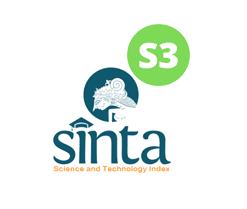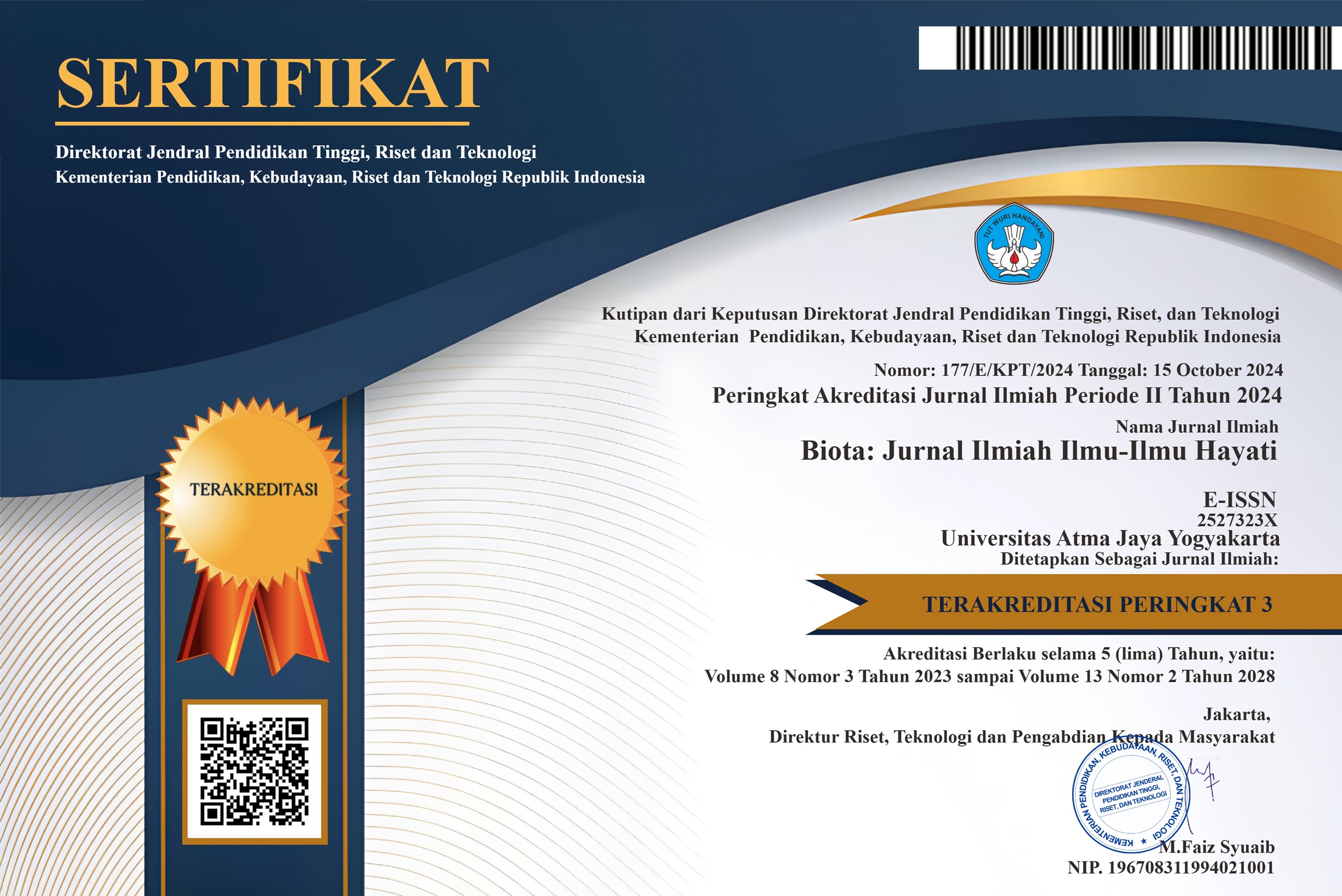Identifikasi Bakteri yang Berperan dalam Pengasaman Kedelai dalam Fermentasi Tempe Berdasarkan Sekuen 16S rDNA
DOI:
https://doi.org/10.24002/biota.v6i2.4029Keywords:
pH, Tempe, Perendaman, Fermentasi, Kedelai, Bakteri, IdentifikasiAbstract
Proses fermentasi dalam pembuatan tempe di Indonesia terdiri atas dua tahap. Tahap pertama berupa perendaman kedelai untuk pengasaman kedelai yang penting bagi pertumbuhan kapang. Dalam tahapan ini jenis mikroba yang berperan adalah kelompok bakteri. Namun informasi tentang jenis bakteri tersebut masih terbatas. Oleh sebab itu penelitian ini bertujuan untuk mengidentifikasi jenis jenis bakteri yang berperan dalam proses pengasaman kedelai saat fermentasi tempe. Isolasi bakteri dilakukan dari tempe yang diambil langsung dari pengrajin tempe di Jakarta. Bakteri ditumbuhkan pada media Plate Count Agar, de Man Rogosa and Sharpe Agar, MacConkey Agar dan Eosin Methylene Blue Agar. Selanjutnya diuji perannya dalam pengasaman kedelai dengan pengukuran pH air rendaman kedelai dan selanjutnya bakteri tersebut diidentifikasi. Ditemukan isolat P211, P3a, Mc4b, B1p, dan Man2b berperan dalam pengasaman dengan menurunkan pH air rendaman kedelai dari 7 menjadi sekitar 4,7 hingga 5,8. Identifikasi berdasarkan sekuen 16S rDNA lima bakteri tersebut masing masing adalah Klebsiella pneumoniae, Enterobacter ludwigii, Enterobacter sp., Lactobacillus agilis, dan Pantoea sp. dengan kemiripan 98-100%. Selanjutnya, perlu diteliti tentang perannya dalam menentukan kualitas tempe.
References
Ayu, E., Suwanto, A., and Barus, T. 2014. Klebsiella pneumoniae from Indonesian tempeh were genetically different from that of pathogenic isolates. Microbiology Indonesia, 8(1), 2-2.
Barus, T., dan Wijaya, L.N. 2011. Mikrobiota dominan dan perannya dalam cita rasa tape singkong. Biota: Jurnal Ilmiah Ilmu-Ilmu Hayati, 16(2), 354-561.
Barus, T., Hanjaya, I., Sadeli, J., LAY, B.W., Suwanto A, and Yulandi, A. 2013. Genetic diversity of Klebsiella spp. isolated from tempe based on enterobacterial repetitive intergenic consensus-polymerase chain reaction (ERIC-PCR). HAYATI Journal of Biosciences, 20(4), 171-176.
Barus, T., Maya, F., dan Hartanti, A.T. 2019. Peran Beberapa Galur Rhizopus microsporus yang Berasal dari “laru tradisional” dalam Menentukan Kualitas Tempe. Jurnal Aplikasi Teknologi Pangan, 8(1).
Barus, T., Suwanto, A., Wahyudi, A. T., and Wijaya, H. 2008. Role of bacteria in tempe bitter taste formation: microbiological and molecular biological analysis based on 16S rRNA gene. Microbiology Indonesia, 2(1), 4-4.
Barus, T., Titarsole, N.N., Mulyono, N., and Prasasty, V.D. 2019. Tempeh Antioxidant Activity using DPPH Method: Effects of Fermentation, Processing, and Microorganisms. Journal of Food Engineering and Technology, 8(2), 75-80.
Barus, T., Wati, L., and Suwanto, A. 2017. Diversity of protease-producing Bacillus spp. from fresh Indonesian tempeh based on 16S rRNA gene sequence. HAYATI Journal of Biosciences, 24(1), 35-40.
Efriwati, Suwanto, A., Rahayu, G., and Nuraida, L. 2013. Population dynamics of yeasts and lactic acid bacteria (LAB) during tempeh production. HAYATI Journal of Biosciences, 20(2), 57-64.
Handajani, Y.S., Turana, Y., Yogiara, Y., Widjaja, N.T., Sani, T.P., Christianto, G.A.M., and Suwanto, A. 2020. Tempeh Consumption and Cognitive Improvement in Mild Cognitive Impairment. Dementia and geriatric cognitive disorders, 1-6.
Ito, M., Ito, T., Aoki, H., Nishioka, K., Shiokawa, T., Tada, H., and Takashiba, S. 2020. Isolation and identification of the antimicrobial substance included in tempeh using Rhizopus stolonifer NBRC 30816 for fermentation. International Journal of Food Microbiology, 108645.
Keuth, S., and Bisping, B. 1994. Vitamin B12 production by Citrobacter freundii or Klebsiella pneumoniae during tempeh fermentation and proof of enterotoxin absence by PCR. Applied and environmental microbiology, 60(5), 1495-1499.
Mardaneh, J. and Dallal, M.M.S., 2013. Isolation, identification and antimicrobial susceptibility of Pantoea (Enterobacter) agglomerans isolated from consumed powdered infant formula milk (PIF) in NICU ward: First report from Iran. Iranian journal of microbiology, 5(3), p.263.
Mignard, S., and Flandrois, J.P. 2006. 16S rRNA sequencing in routine bacterial identification: a 30-month experiment. Journal of microbiological methods, 67(3), 574-581.
Pangastuti, A., Alfisah, R.K., Istiana, N.I., Sari, S.L.A., Setyaningsih, R., Susilowati, A. and Purwoko, T., 2019. Metagenomic analysis of microbial community in over-fermented tempeh. Biodiversitas Journal of Biological Diversity, 20(4), pp.1106-1114.
Pangastuti, A., Alfisah, R.K., Istiana,N.I., Arum, Siti Lusi Arum Sari, Ratna Setyaningsih, Ari Susilowati, and Tjahjadi Purwoko. "Metagenomic analysis of microbial community in over-fermented tempeh." Biodiversitas Journal of Biological Diversity 20, no. 4 (2019): 1106-1114.
Patel, J.B. 2001. 16S rRNA gene sequencing for bacterial pathogen identification in the clinical laboratory. Molecular diagnosis, 6(4), 313-321.
Podschun R., and Ullmann U. 1998. Klebsiella spp. as nosocomial pathogens: epidemiology, taxonomy, typing methods, and pathogenicity factors. Clin Microbiol Rev 11:589-603.
Radita, R., Suwanto, A., Kurosawa, N., Wahyudi, A.T., and Rusmana, I. 2018. Firmicutes is the predominant bacteria in tempeh. International Food Research Journal, 25(6), 2313-2320.
Radita, R., Suwanto, A., Kurosawa, N., Wahyudi, A.T. and Rusmana, I., 2017. Metagenome analysis of tempeh production: Where did the bacterial community in tempeh come from?. Malaysian Journal of Microbiology, 13(4), pp.280-288.
Roubos-van den Hil, P.J., Nout, M.R., van der Meulen, J., and Gruppen, H. 2010. Bioactivity of tempe by inhibiting adhesion of ETEC to intestinal cells, as influenced by fermentation substrates and starter pure cultures. Food microbiology, 27(5), 638-644.
SNI (Standar Nasional Indonesia) 3144-2015. 2015. Tempe Kedelai. Badan Standarisasi Nasional. Jakarta
Soka, S., Suwanto, A., Sajuthi, D., and Rusmana, I. 2014. Impact of tempeh supplementation on gut microbiota composition in Sprague-Dawley rats. Research Journal of Microbiology, 9(4), 189.
Stephanie, S., Ratih, N.K., Soka, S., and Suwanto, A. 2017. Effect of tempeh supplementation on the profiles of human intestinal immune system and gut microbiota. Microbiology Indonesia, 11(1), 2.
Yoon, S.H., Ha, S.M., Kwon, S., Lim, J., Kim, Y., Seo, H., and Chun, J. 2017. Introducing EzBioCloud: a taxonomically united database of 16S rRNA gene sequences and whole-genome assemblies. International journal of systematic and evolutionary microbiology, 67(5), 1613.
Downloads
Published
How to Cite
Issue
Section
License
Copyright (c) 2021 Tati Barus, Widyah Widyah, Wisnu Adi Wicaksono, Vivitri Dewi Prasasty

This work is licensed under a Creative Commons Attribution-NonCommercial 4.0 International License.
Authors who publish with Biota : Jurnal Ilmiah Ilmu-Ilmu Hayati agree to the following terms:
- Authors retain copyright and grant the Biota : Jurnal Ilmiah Ilmu-Ilmu Hayati right of first publication. Licensed under a Creative Commons Attribution-NonCommercial 4.0 International License that allows others to share the work with an acknowledgment of the work's authorship and initial publication in this journal.
- Authors are able to enter into separate, additional contractual arrangements for the non-exclusive distribution of the journal's published version of the work (e.g., post it to an institutional repository or publish it in a book), with an acknowledgment of its initial publication in Biota : Jurnal Ilmiah Ilmu-Ilmu Hayati, and as long as Author is not used for commercial purposes.













